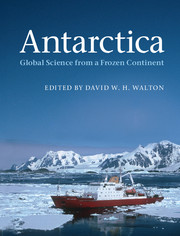Book contents
- Frontmatter
- Contents
- List of contributors
- Introduction
- 1 Discovering the unknown continent
- 2 A keystone in a changing world
- 3 Ice with everything
- 4 Climate of extremes
- 5 Stormy and icy seas
- 6 Life in a cold environment
- 7 Space science research from Antarctica
- 8 Living and working in the cold
- 9 Scientists together in the cold
- 10 Managing the frozen commons
- 11 Antarctica: a global change perspective
- Appendix A Visiting Antarctica
- Appendix B Further reading
- Acknowledgements
- Index
6 - Life in a cold environment
Published online by Cambridge University Press: 05 March 2013
- Frontmatter
- Contents
- List of contributors
- Introduction
- 1 Discovering the unknown continent
- 2 A keystone in a changing world
- 3 Ice with everything
- 4 Climate of extremes
- 5 Stormy and icy seas
- 6 Life in a cold environment
- 7 Space science research from Antarctica
- 8 Living and working in the cold
- 9 Scientists together in the cold
- 10 Managing the frozen commons
- 11 Antarctica: a global change perspective
- Appendix A Visiting Antarctica
- Appendix B Further reading
- Acknowledgements
- Index
Summary
The ship was stopped to take soundings and to dredge, and a good haul was brought up from the bottom of the most beautiful things imaginable. The bottom of this sea must be covered with the most wonderful collection of starfish, sea urchins, Polyzoa, crustaceans, etc. All fairy-like delicate things that reminded one much more of the Tropics but all living at a temperature of 29°F.
Edward Wilson, Diary of the Discovery ExpeditionAntarctica is a good place to study both evolution and adaptation. Despite the low temperatures and lack of liquid water on land, and the effects of sea ice and temperatures just above freezing in the sea, Antarctic organisms have found ways not only to survive but to thrive in what to us seem very difficult environmental conditions. Its unusual evolutionary history, from Gondwana supercontinent to the present day, together with a climate that has now been cold for at least 25 million years, gives Antarctic biodiversity some unique features, whilst the survival techniques that its plants, animals and microbes have developed can provide important insights into the physiological and biochemical ways in which organisms function. It is on land that physical environmental extremes are perhaps most obvious, and the continent's terrestrial habitats include some of the coldest, driest, windiest and most abrasive to be found anywhere on Earth. Less than 0.4% of the Antarctic is ever free of ice or snow cover, and even then this may be for as little as a few days or weeks during the height of the summer. In this respect Antarctica is strikingly different to the Arctic. The latter experiences a similar radiation (daylength) regime, determined by latitude, which means that both polar regions face similar thermal stresses during their winter months when the input of solar energy is absent. In summer, the almost complete ice cover of Antarctica gives it a very high albedo, reflecting virtually all incoming solar radiation back up through the atmosphere. In contrast, large areas of the northern continents and archipelagos, and, increasingly, the surface of the Arctic Ocean, become ice free for several months during summer, enabling the absorption of solar radiation and leading to temperatures several degrees higher on average than at comparable Antarctic latitudes, sufficient to support considerable biological productivity.
- Type
- Chapter
- Information
- AntarcticaGlobal Science from a Frozen Continent, pp. 161 - 210Publisher: Cambridge University PressPrint publication year: 2013
- 4
- Cited by



